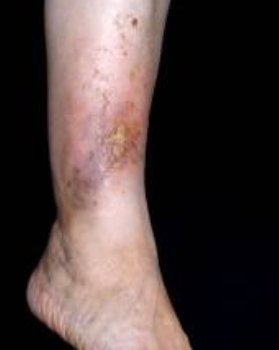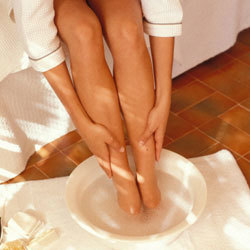
Varicose veins (phlebitis) is one of the most common and ancient of diseases of the cardiovascular system, which opened the era of ancient Egypt. With the help of the egyptian scrolls and excavations, found the mummy with the symptoms of varicose veins. This disease makes us famous ancient doctors: Hippocrates, Galena, Avicenna, later Troyanova, Trendelenburg. Ido far this disease has not lost its value in modern medicine. The definition of "varicose veins" comes from the Latin word "varix", which means "extension", therefore, the disease took the name "varicose veins". This disease is characterized by the extension and increasing the length of the peripheral vein as a serpentine tortuosity (deformations), as well as reduced outflow of blood from those arising as a result of the failure device valve and weakening their walls. The disease most often affects veins of the lower limbs, as well as the main load outflow of blood (big volume) we need to be in them, therefore, priority is given in this section. Varicose veins meets approximately 17 - 25% of the population. At a young age the disease occurs in the same way, both boys and girls. At the ripe age of women sick 2 - 3 times more often than men due to the hormonal adaptation of the female body (menstruation, pregnancy, menopause).
The causes and risk factors in the development of varicose veins
The exact cause of the disease is not known, all we know is that under the influence of certain factors develops weakening of the valve, the pressure increase and loss of elasticity of the wall surface and the connective veins. Risk factors:
- Genetic predisposition: the transfer of varicose veins is hereditary, resulting from mutations of the gene which is responsible for the structure of the wall of the vessel, with the result that the mutation children are born with an innate weakness of the connective or muscular tissue of the vessel wall, or the disadvantage of the valve (the lack of their number), and as a consequence arises the weakness of the vessel wall and increased pressure in the veins.
- Hormonal changes (pregnancy, menopause): when pregnancy changes the hormonal composition of the body (increased levels of progesterone and decrease of estrogen), affecting the formation of coagulation factors of the blood (increase), decrease of tone of the vein wall (as a result of the destruction of collagen and elastic fibers of the vessel wall) all of this leads to the formation of blood clots, obstruction of blood vessels and their deformation.
- Obesity : obesity leads to a sedentary lifestyle, as a result of which the deceleration of blood circulation, plus excess fat increases the intra-abdominal pressure, which disrupts the flow of blood through the veins, resulting in a growing stagnation in the veins and the possible progression of the disease.
- Diabetes :chronic elevated levels of blood sugar over time damages the walls of blood vessels, which is a favorable environment for the development of blood clots.
- Alcohol abuse : excessive alcohol consumption leads to dehydration and hardening of the blood to form blood clots, which clog the vienna and violate the outflow of blood.
- Lifting weights (promoters),prolonged walking next few years or a permanent job (salesmen, conductors): it has to do with the reduction of muscle tone, increased intra-abdominal pressure and, consequently, a slowing down and obstruction of blood flow to the heart and the development of stagnation in the lower extremities.
- Congenital disorders of blood coagulation: a relative hypercoagulability (excessive production of factors foldable blood) leads to the formation of blood clots and the promotion of blood from the blood vessels.
- Improper diet: lack of certain vitamins in food (vit.C, E, K, dietary fiber play a role in strengthening the wall of blood vessels and improving the circulation of the blood).
- Wearing tight underwear: permanent transfer leads to compression of veins, that causes difficulty in the venous drainage from lower limbs.
- Chronic constipation : frequent increase in intra-abdominal pressure (during exercise) leads to difficulty of outflow of blood from the lower extremities.
- The frequent walking in high heels: the lack of motion of the muscles of the legs and the development of stagnation.
- Warm season: frequent dehydration leading, dehydration occurs coagulation of blood and the formation of blood clots.
- Concomitant diseases of the cardiovascular system or kidney disease: impaired venous blood flow (insufficiency of the heart valves, congenital malformations).
- Overdose of drugs increase the coagulation of the blood: the risk of blood clots and blockage of blood vessels.
- Surgeries:loss of a volume of blood, is not an appropriate position on the surgical table (compression of certain blood vessels), leading to the risk of developing blood clots.

Complications of varicose veins
- The formation of blood clots, resulting in the stagnation of blood in the veins?
- detachment of the thrombus and occlusion of the vessel, which fits with the diameter of it?
- thrombophlebitis (as a result of the formation of a clot in the lumen of the vein occurs inflammation wall);
- pulmonary embolism (detached blood clot-current blood enters the pulmonary artery, which participates in the flow of blood in a small circle. If the diameter of the thrombus matches the diameter of the trunk of this artery, then it can happen sudden death. If the clot is less than the diameter, it passes up to a branch of the pulmonary artery, causing infarction of the lung or swelling).
- trophic ulcer or eczema in the legs resulting in eating disorders (violation of circulation of blood leads to a negative oxygen to the tissues, which is the main food of the tissues of the body);
- swelling of various parts of the body as a result of the stagnation in your veins (it is soft, elastic, cyanotic colors, their education does not depend on the time of day, often formed in the vicinity of the affected area);
- dermatitis (inflammation of the skin in the affected area) due to disturbances in the operation of this phase?
- change the color of the skin in the area of the affected area?
- seal subcutaneous fat fibre, in the area of the affected region through the swelling.
The diagnosis of varicose veins
- The flagellum (operational) samples (definition of the veins and the condition of the valve): Troyanova - Trendelenburg,Pratt, Shania, Delbe-Pertesa and more. One of the most common test Troyanova - Trendelenburg during which the patient is in a horizontal position, lifts the leg at 45 0, the doctor makes stroke of the foot upward (with the result that emptied the superficial veins), then make a tourniquet to the upper part of the thigh and asks the patient to stand in normal filling of the veins of the lower leg should happen for more than 15 seconds?
- Duplex ultrasound of the veins (ultrasonic angioscanning) most informative method allows you to evaluate the blood flow in the vessel and to see the same ship?
- Dopplerhophy - method, in which assess only the flow of blood in this boat?
- Phlebography - x- introduction of contrast medium intravenously and x-ray study plans?
- Phleboscintigraphy - intravenous radiopharmaceutical and monitoring in a special device.
The treatment of varicose veins
Non-surgical treatment

- Folk remedies (except medical treatment): wearing compression stockings (socks); special exercise (swim, bike, ski, walk over the head for about 20 0 in relation to beds, special gymnastics ("bike" - lying on your back and smoothly breath, imagine that you spin the pedals on a bike? alternately bend and unbend leg, ankle of the foot forward and back) that are applied to improve the outflow of blood, but only in non-complex cases); a contrast shower (under running water to keep the feet, gradually reducing the temperature of the water reaches the cold); + basin (not hot) from the decoction of the bark of oak, chestnut, chamomile, st. john's wort for? rubbing tincture of flowers of white acacia, the leaves of kalanchoe, apple cider vinegar for? with thrombophlebitis treatment with leeches.
- Operation day: in the morning the slow exit from the bed (within about 5-10 minutes), during sleep puts pad under the heel to lift your legs for about 15-20 0 in relation to the bed, the walk must be calm, can not sit crossed leg in leg tied up leg, elastic bandage, starting from the leg to the upper part of the thigh, wearing medical socks, nutrition, avoid any strenuous movements, and any substances or factors that contribute to the hardening of the blood, elimination of smoking, prevention of constipation.
- Diet : the body required products containing vitamins strengthen the walls of blood vessels and improve blood circulation: vitamin c (with citruses, tomatoes, wild rose, etc.), vitamin E (legumes, liver, egg yolk, green onions), vitamin P (grapefruit, walnut, black currant), bioflavonoids (dark cherries, sour cherry), copper (seafood). A sufficient daily amount of water at least 1.5 liter. Limited the use of alcoholic beverages, coffee, marinades, smoked.
The surgical treatment

Phlebotomy:Evidence for vein removal: extensive varicose veins, subcutaneous veins pathologically expanded, trophic disorders of the skin that do not respond to conservative treatment, acute thrombophlebitis, varicose subcutaneous veins accompanied by violation of the general condition (severe fatigue, swelling of the legs) of the patient. Contraindications to the removal veins: coronary artery disease, severe infectious processes, third age of the patient, the pregnancy during the 2 and 3 quarter, inflammatory processes in the legs (erysipelas, pyoderma, eczema). The benefits of the surgical treatment: the only way for the treatment in advanced cases, the only active method for the correction of the valve deep veins. Disadvantages of surgical treatment: traumatic (aesthetic defect), requires sedation, should be located several days in the hospital under the supervision of the surgeon. Laser treatment (endovascular microtermocoagulation) :Testimony: the Combination of varicose veins with the following diseases: diseases of the cardiovascular system (coronary heart disease, increased blood pressure), diseases of peripheral vessels (phlebitis, thrombophlebitis), respiratory diseases (bronchial asthma, bronchitis, pleurisy), digestive diseases (cholecystitis, ulcers disease stomach and duodenal ulcers), diseases of the nervous system (cranio-cerebral injury, cns), diseases of the urinary tract (pyelonephritis, endometritis, salpingitis), with skin diseases (dermatitis, Neurodermatitis), peritonitis, boils. Contra-indications: people suffering from cancer, diseases of the liver, of the kidneys and of the heart in the phase of decompensation, cerebral sclerosis, pregnancy. Advantages: allows you to get rid of the poor vascular image, quick procedure (15-20min), does not require hospitalization, safe and painless, are not injured by a vessel of the tissue and the surrounding tissue. Cons: not everywhere available method, a costly method, when you delete most large vessels can heat damage possible scarring, and discoloration (whitening) of the skin in areas of exposure. Radiofrequency coagulation (ablation) of varicose veins: Indications: varicose disease with the defeat of the trunk large and small subcutaneous veins, trophic ulcers on the result of varicose veins. Contraindications: acute thrombophlebitis subcutaneous veins, the inability to be active with the feet, pregnancy, mental health disorders. Advantages: without the cosmetic defect, painless, requires no hospitalization, does not violate earning ability. Cons: the only drawback is the price of the procedure. Sclerotherapy: Indications: small varicose veins, large varicose veins by using duplex dopplerography, varicose veins in the early stages (when it is damaged only superficial veins. Contraindications: pregnancy and breast-feeding, allergic to sclerosus, deep vein thrombosis, pyo-inflammatory diseases of the feet. Advantages: lower cost compared with the surgery, quick recovery period, does not require a stay in the hospital (you can immediately go home), the best aesthetic result. Disadvantages:possible penetration in the deep veins sclerosus, decreased efficiency due to the mixing sclerosus with his blood, is not effective in advanced cases.




































